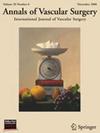Open Versus Endovascular Repair of Patent Popliteal Artery Aneurysms in an Elective Setting: A Multicenter Retrospective Study with Long-Term Follow-Up
IF 1.4
4区 医学
Q3 PERIPHERAL VASCULAR DISEASE
引用次数: 0
Abstract
Background
The aim of this study is to investigate long-term outcomes of open repair (OR) versus endovascular popliteal aneurysm repair (EPAR) for popliteal artery aneurysms (PAAs) in an elective setting.
Methods
A retrospective analysis was performed on all patients treated for a popliteal aneurysm with OR and EPAR between 2010 and 2020 in 2 high-volume centers. Primary endpoints were freedom from amputation and overall patency. Secondary endpoints included secondary patency, reinterventions rates and predictors of late failure. Follow-up protocol included clinical examination and duplex ultrasound at 1, 6, 12 months, and annually thereafter. The Chi-square test was used to assess differences in categorical outcomes and Student's t-test in continuous outcomes. A P value of less than 0.05 was considered statistically significant.
Results
Between 2010 and 2020, 143 limbs from 120 patients were treated for PAA in an elective setting: 70 limbs with OR and 73 with EPAR. Primary patency at 1, 3, and 5 years were 92.7%, 92.7%, and 81% for OR and 77.3%, 67.9%, and 64.1% for EPAR respectively (P = 0.01). There was a significant difference in terms of 1-year patency for patients with 2–3 runoff vessels between OR and EPAR (96.1% vs. 82.7 respectively, P = 0.03). Reintervention rate was different between the groups with freedom from reintervention at 1, 3, and 5 years all of 95.7% for OR and 82.2%, 70.9%, and 70.9% for EPAR (P = 0.02). The 1-, 3-, and 5-year secondary patency did not differ between the groups and was 100%, 97.6%, and 90.6% for OR and 94%, 91.3%, and 88.4% for EPAR (P = 0.3). Freedom from amputation was excellent for both groups (100% for OR and 99% for EPAR, P = 0.5). The presence of 2–3 runoff vessels was a relevant protective moderator with a relative risk of 0.6 (P = 0.08).
Conclusion
OR and EPAR are comparable therapeutic options for the treatment of asymptomatic PAAs in terms of secondary patency and freedom from amputation despite an increasing rate of late occlusions and reintervention in EPAR group. The difference in primary patency between the 2 techniques seems more significant within the first-year of follow-up for those patients with a better runoff.
开放性与血管内修复腘动脉未闭动脉瘤的选择性:一项长期随访的多中心回顾性研究
本研究的目的是探讨开放性修复(OR)与血管内腘动脉瘤修复(EPAR)治疗腘动脉动脉瘤(PAAs)的长期预后。方法回顾性分析2010年至2020年在2个大容量中心接受OR和EPAR治疗的所有腘动脉瘤患者。主要终点为截肢自由和整体通畅。次要终点包括二次通畅、再干预率和晚期失败的预测因子。随访方案包括临床检查和双工超声在1、6、12个月,此后每年。分类结果的差异采用卡方检验,连续结果的差异采用t检验。P值小于0.05认为有统计学意义。结果2010年至2020年间,120例患者的143条肢体在选择性环境中接受了PAA治疗:70条肢体为OR, 73条肢体为EPAR。OR组1、3、5年的原发性通畅率分别为92.7%、92.7%、81%,EPAR组为77.3%、67.9%、64.1% (P = 0.01)。有2-3根径流血管的患者的1年通畅率在OR和EPAR之间有显著差异(分别为96.1%和82.7%,P = 0.03)。1、3、5年无再干预组的再干预率均有差异,OR组为95.7%,EPAR组为82.2%、70.9%、70.9% (P = 0.02)。1、3、5年继发通畅率组间无差异,OR组为100%、97.6%、90.6%,EPAR组为94%、91.3%、88.4% (P = 0.3)。两组的截肢自由度均极好(OR组为100%,EPAR组为99%,P = 0.5)。2-3个径流血管的存在是一个相关的保护性减缓剂,相对风险为0.6 (P = 0.08)。结论在无症状PAAs的治疗中,尽管EPAR组晚期闭塞率和再干预率增加,但在继发通畅和免于截肢方面,or和EPAR是可比较的治疗选择。两种技术在原发性通畅方面的差异在术后第一年的随访中更为显著。
本文章由计算机程序翻译,如有差异,请以英文原文为准。
求助全文
约1分钟内获得全文
求助全文
来源期刊
CiteScore
3.00
自引率
13.30%
发文量
603
审稿时长
50 days
期刊介绍:
Annals of Vascular Surgery, published eight times a year, invites original manuscripts reporting clinical and experimental work in vascular surgery for peer review. Articles may be submitted for the following sections of the journal:
Clinical Research (reports of clinical series, new drug or medical device trials)
Basic Science Research (new investigations, experimental work)
Case Reports (reports on a limited series of patients)
General Reviews (scholarly review of the existing literature on a relevant topic)
Developments in Endovascular and Endoscopic Surgery
Selected Techniques (technical maneuvers)
Historical Notes (interesting vignettes from the early days of vascular surgery)
Editorials/Correspondence

 求助内容:
求助内容: 应助结果提醒方式:
应助结果提醒方式:


